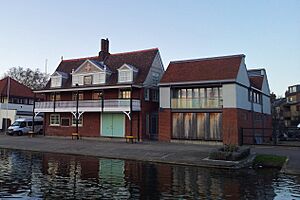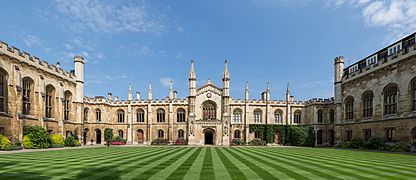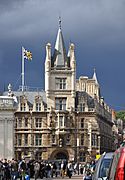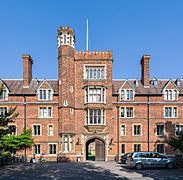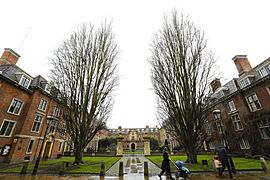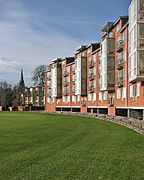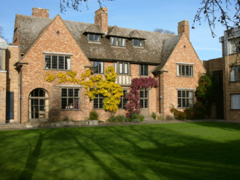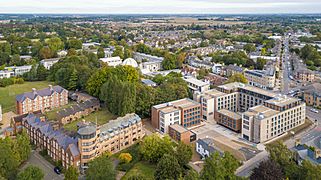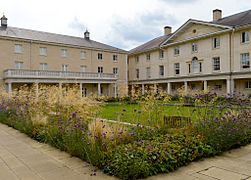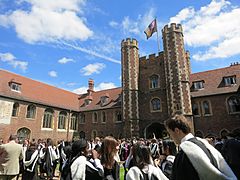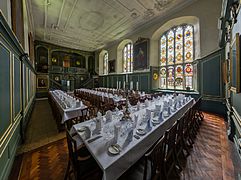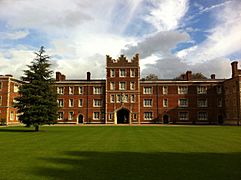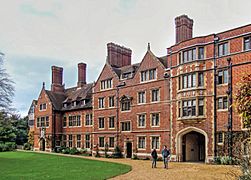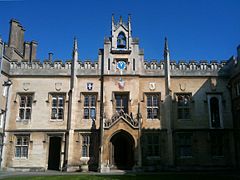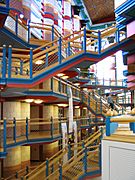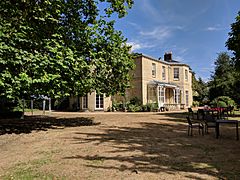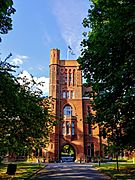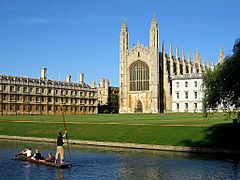University of Cambridge facts for kids

Coat of arms
|
|
| Latin: Universitas Cantabrigiensis | |
|
Other name
|
The Chancellor, Masters and Scholars of the University of Cambridge |
|---|---|
| Motto | Latin: Hinc lucem et pocula sacra |
|
Motto in English
|
Literal: From here, light and sacred draughts. Nonliteral: From this place, we gain enlightenment and precious knowledge. |
| Type | Public research university Ancient university |
| Established | c. 1209 |
| Endowment | £2.62 billion (2024; excluding colleges) |
| Budget | £2.24 billion (2023/2024; excluding colleges) |
| Chancellor | The Lord Smith of Finsbury |
| Vice-Chancellor | Deborah Prentice |
|
Academic staff
|
6,090 (2023/24) |
|
Administrative staff
|
7,105 (2023/24) |
| Students | (2015/16) 21,175 FTE (2015/16) |
| Undergraduates | (2015/16) |
| Postgraduates | (2015/16) |
| Location |
,
England
|
| Campus |
|
| Colours | Cambridge Blue |
| Affiliations |
|
 |
|
The University of Cambridge is a famous public university in Cambridge, England. It was founded in 1209, making it the third-oldest university in the world that is still running. The university started when scholars left the University of Oxford after a disagreement with the local people. Cambridge and Oxford are two of England's oldest universities and are often called Oxbridge.
The university is made up of 31 colleges and over 150 departments. Each college is a self-governing community where students live and study. All students must belong to a college. Teaching at Cambridge includes small group sessions called supervisions, as well as lectures and lab work.
Cambridge has eight museums and a botanic garden. Its 116 libraries hold about 16 million books. The main library, Cambridge University Library, is one of the largest academic libraries in the world.
People connected to Cambridge have won 124 Nobel Prizes. Famous people who studied at Cambridge include scientists like Isaac Newton, Charles Darwin, and Stephen Hawking. It has also educated writers like John Milton and Sylvia Plath, and world leaders like Jawaharlal Nehru.
Contents
History of the University
How Cambridge University Started
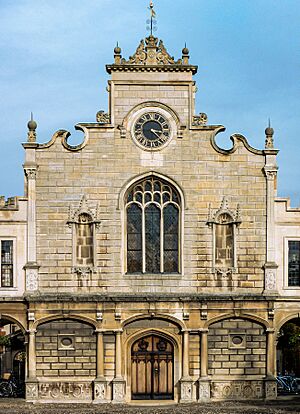
The University of Cambridge was founded in 1209. It began when scholars from the University of Oxford had a dispute with the townspeople there. Fearing for their safety, many scholars left Oxford and moved to other cities, including Cambridge.
Enough scholars settled in Cambridge to form a new university. By 1225, the university had a leader called a chancellor. In 1231, King Henry III gave the university a royal charter, which was an official recognition. This helped the university grow and attract researchers from all over Europe.
The First Colleges
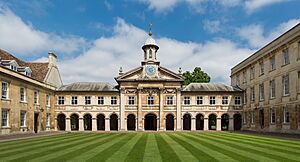
The colleges are a key part of Cambridge, but they were created after the university itself. The first college, Peterhouse, was founded in 1284. Many more colleges were built in the 14th and 15th centuries.
In the Middle Ages, colleges were often founded so people could pray for the souls of the founders. But in 1536, King Henry VIII ordered the university to change its focus. Instead of religious law, students began to study classics, the Bible, and mathematics.
A Leader in Math and Science
Cambridge quickly became a world leader in mathematics. For a long time, all students had to take a difficult math exam called the Mathematical Tripos. The top student was called the Senior Wrangler, which was seen as a huge achievement.
This focus on math helped produce famous scientists like Isaac Newton, James Clerk Maxwell, and Lord Kelvin. In the 20th century, Cambridge also became a top center for pure mathematics, thanks to mathematicians like G. H. Hardy and Srinivasa Ramanujan.
Women at Cambridge
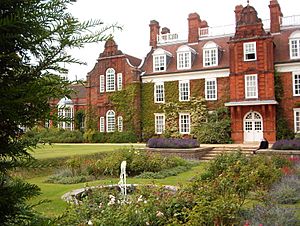
For centuries, only men could study at Cambridge. The first college for women, Girton College, was founded in 1869. Newnham College followed in 1872.
Even though women could study and take exams, they were not officially awarded degrees until 1948. Before then, they received diplomas instead. Starting in 1972, the men's colleges began to admit women. Today, most colleges are for both men and women. Only two colleges, Newnham and Murray Edwards, admit only women.
University Buildings and Locations
The university is located in the center of the city of Cambridge. Many of its older colleges are near the River Cam. A popular activity is to go punting on the river, which offers beautiful views of the college buildings.
Some of the most famous buildings include King's College Chapel and the Senate House, where students graduate. The university is spread across several sites, each with different departments. For example, the West Cambridge site is home to many science and technology departments.
Because the city is flat and parking is limited, many students travel by bicycle. It is estimated that one-fifth of all journeys in Cambridge are made by bike.
How the University is Organized
Cambridge is a collegiate university. This means it is made up of independent colleges and academic departments.
The Colleges
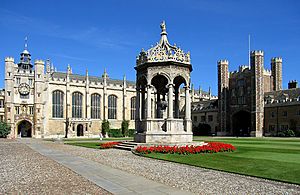
There are 31 colleges at Cambridge. Each one is a self-governing community with its own buildings, staff, and students. The colleges provide housing, meals, and social activities. They are also where students receive their small-group teaching, called supervisions.
Each college admits its own undergraduate students. While some colleges are known for certain subjects, most offer a wide range of courses. For example, Churchill College is famous for science and engineering.
Schools and Departments
The university's teaching and research are organized into six "Schools." These are large groups of related subjects, such as Arts and Humanities, Biological Sciences, and Technology.
Within these schools are over 150 departments and faculties. The departments are responsible for lectures, lab work, and exams. For example, the Faculty of Law organizes all the teaching for law students.
Student Life
Studying at Cambridge
The academic year is divided into three terms: Michaelmas (autumn), Lent (winter), and Easter (spring). Each term is only eight weeks long, so students are expected to study hard during the holidays as well.
The main teaching method for undergraduates is the supervision system. In a supervision, one or two students meet with a professor or researcher for an hour to discuss their work. This system allows students to get personal feedback and explore subjects in depth.
Traditions and Events
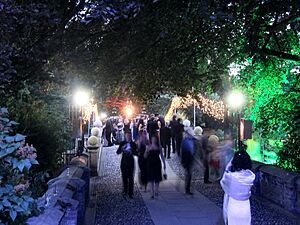
Cambridge has many traditions. One is the Formal Hall, a special dinner where students wear their academic gowns. Another is the May Ball, a huge party held in the colleges after exams are over.
A famous Christmas tradition is the Festival of Nine Lessons and Carols, broadcast live from King's College Chapel. It is heard by millions of people around the world.
Sports and Societies
Rowing is a very popular sport at Cambridge. The biggest event is the annual Boat Race against the University of Oxford. There are also many other sports teams that compete against Oxford in "varsity matches."
There are hundreds of student societies for almost any interest, from drama and music to politics and chess. The Cambridge Union is the world's oldest debating society and often hosts famous speakers. The Footlights is a comedy club that has produced many famous actors and comedians.
Famous People from Cambridge
The University of Cambridge has educated many people who have changed the world.
- Scientists: Isaac Newton discovered the laws of gravity and motion. Charles Darwin developed the theory of evolution. Stephen Hawking was a brilliant physicist who studied black holes. Francis Crick and James Watson discovered the structure of DNA.
- Writers: Poets like John Milton (Paradise Lost) and Lord Byron studied here. The university also educated famous novelists like Vladimir Nabokov and Zadie Smith.
- Actors and Comedians: Many famous performers are Cambridge alumni, including Ian McKellen, Emma Thompson, Hugh Laurie, Tilda Swinton, John Cleese, and Sacha Baron Cohen.
- World Leaders: Cambridge has educated 14 British Prime Ministers and many leaders from other countries. The current king of the United Kingdom, Charles III, also studied at Cambridge.
Gallery
-
Great Court at Trinity College
-
New Court at Corpus Christi College
-
Gatehouse at Gonville and Caius College
-
First Court at Pembroke College
-
Gatehouse at Selwyn College
-
Main Court at St Catharine's College
-
Hughes Hall and Fenner's
-
Bredon House at Wolfson College
-
West Lodge Garden at Downing College
-
Old Gatehouse at Queen's College
-
Dining Hall at Magdalene College
-
Chapel Court at Jesus College
-
Second Court at St John's College
-
The Cavendish Building at Homerton College
-
The chapel at Sidney Sussex College
-
The Grove at Fitzwilliam College
-
Gatehouse at Girton College
-
Punting on the River Cam by the west end of King's College Chapel
See also
 In Spanish: Universidad de Cambridge para niños
In Spanish: Universidad de Cambridge para niños
- Armorial of British universities
- Cambridge University Constabulary
- Cambridge University primates
- Coat of arms of the University of Cambridge
- List of medieval universities
- List of Nobel laureates affiliated with the University of Cambridge
- List of organisations and institutions associated with the University of Cambridge
- List of organisations with a British royal charter
- List of professorships at the University of Cambridge
- List of universities in the United Kingdom



